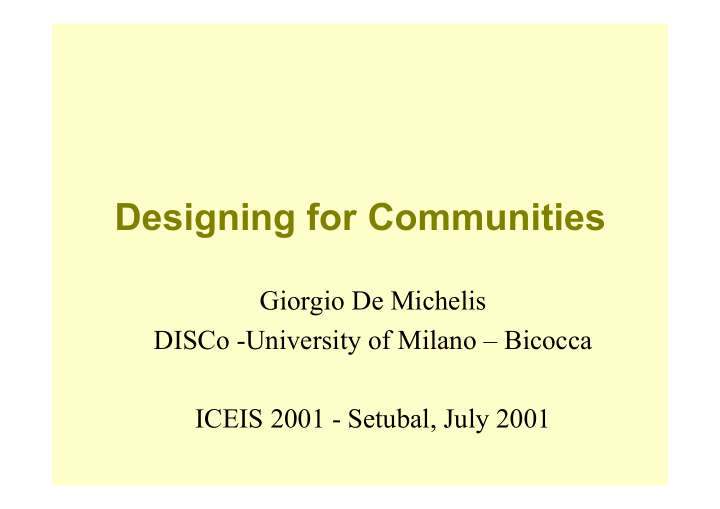



Designing for Communities Giorgio De Michelis DISCo -University of Milano – Bicocca ICEIS 2001 - Setubal, July 2001
Table of Content • Introduction: my experience • The Evolution of Information Systems • Basic elements on Knowledge Management • Cooperative Information Systems • Conclusion
Introduction: my experience
1996-1999 • CIS - Cooperative Information Systems: Euro-Canadian Initiative sponsored by EC, involving also the following Universities: – Toronto and British Columbia in Canada; – Aachen, Hamburg and Namur in Europe.
1997 • The feasibility study of the functional architecture of the RUPA: the Italian Government Public Network – Internet as a middleware
1998-2004 • Two EC funded Knowledge Management projects: Klee&Co (1998-2000) and Milk (2001-2004) – Supporting Context Awareness, – Providing Knowledge On-Line – Multi-Disciplinary Design
The evolution of Information Systems
Important Facts about Information Systems • Reusing old stuff – Migrating Legacy Systems – Integrating old and new Data-Bases • Designing new Systems – ERP
Architectural Issues • Standards (Corba, …) • Middleware layers • Data Warehouses
On-Line Executive Information Systems • Supporting the various aspects of management • Providing on-line information • Integrating knowledge from different sources
Basic Elements on Knowledge Management
Why is Knowledge relevant, today • The Value of Knowledge • Know-how and Know-why • Tacit and Explicit Knowledge • Other’s Knowledge On-line in the processes • A pact between Organization and People
Knowledge Creation (Nonaka, Takeuchi) Tacit knowledge Explicit knowledge to Socialization Externalization Tacit knowledge from Internalization Combination Explicit knowledge
Situating users and objects
The view with context
Coupling knowledge sharing and communication
Klee&Co architecture
Cooperative Information Systems
The three Facets of an Information System Practical Managerial perspective perspective Organizational Group Facet Collaboration Facet Systems Facet Operational Perspective
The Dynamics at the Interaction Level defines what is possible Group Execution Model Organizational Collaboration Model Support modifies
Conclusion
Open Issues • From Interaction to Functions • Creating a Technical Infrastructure • An Evolutionary Approach • Multi-disciplinary Design
Recommend
More recommend